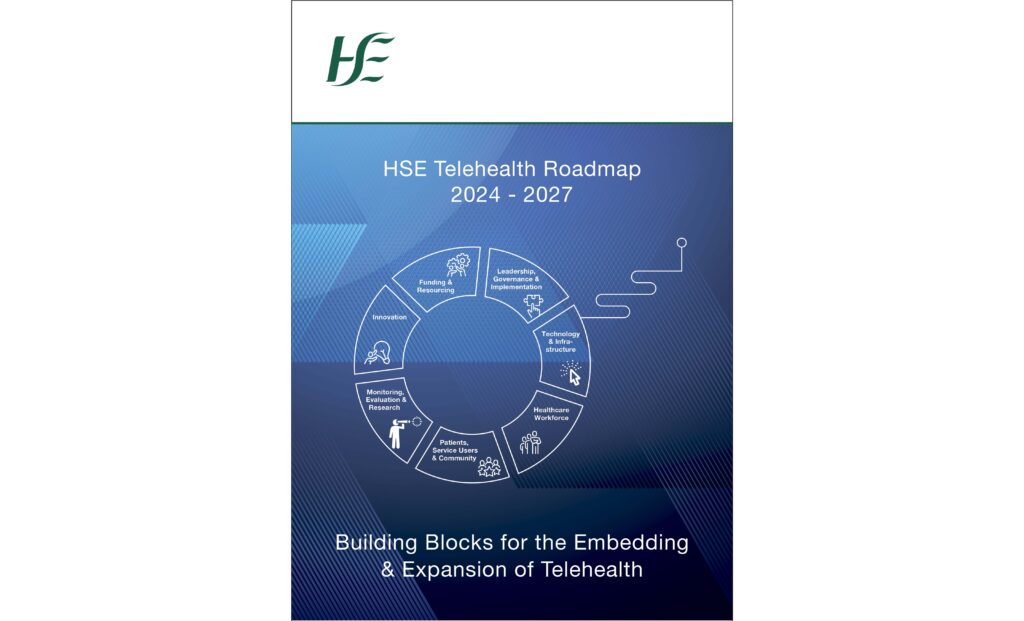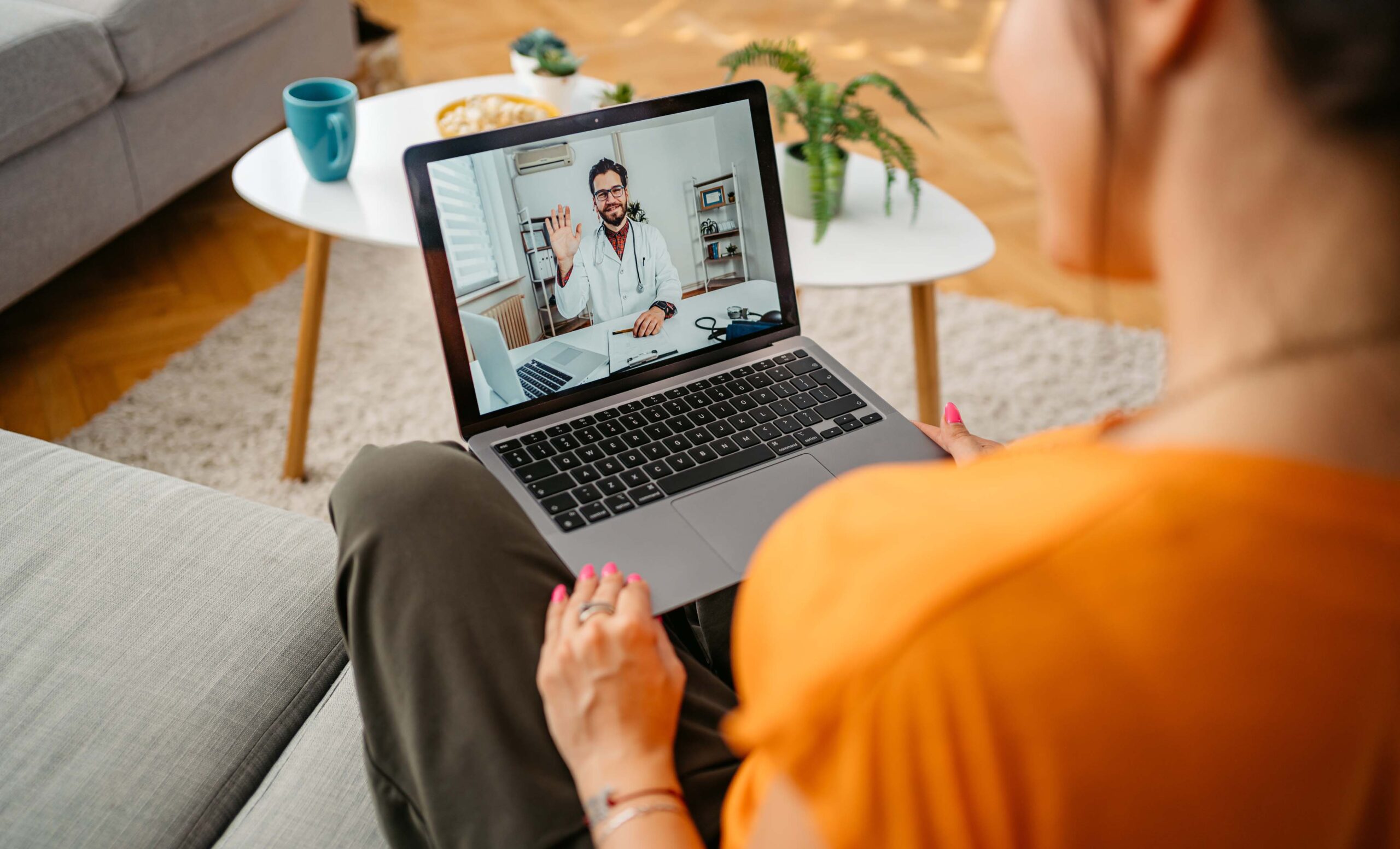The HSE recently launched a new telehealth roadmap that aims to develop remote consultations within healthcare. Niamh Cahill reports
Before the Covid‑19 pandemic, while the number of telemedicine services was growing, remote consultations still represented a very small proportion of the overall volume of health services.
The fact is noted in an OECD report, published in January 2023, titled The future of telemedicine after Covid-19.
The report is a reminder of the pandemic’s lasting impact on healthcare internationally, while shedding light on telemedicine practices and attitudes in various countries.
In Ireland, since 2020, around two million virtual consultations via telephone or video have been performed under the auspices of the HSE.
In an attempt to build on these developments, the Executive recently revealed plans to further increase its use of telehealth services in the future.
Mr Fran Thompson, HSE Chief Information Officer, said that despite the Covid-19 pandemic’s widespread negative effects, it had a positive impact in promoting digitisation in healthcare.
“For example, people are using video calls, Zoom and so forth, in ways they feel are normal now, whereas before the pandemic it felt abnormal. Telehealth is an extension of that,” Mr Thompson told the Medical Independent (MI).
Roadmap
The HSE Telehealth Roadmap 2024-2027: Building blocks for the embedding and expansion of telehealth was launched in December. It details plans to “transform the future of healthcare by improving outcomes, experience, and safety for patients and staff”.
The phrases ‘telemedicine’ and ‘telehealth’ are often used interchangeably, although telehealth can have a slightly wider definition.
Telemedicine is defined as the remote diagnosis and treatment of patients using information technology (IT).
The World Health Organisation (WHO) states telehealth involves the “delivery of healthcare services, where patients and providers are separated by distance”.
“Telehealth uses IT for the exchange of information for the diagnosis and treatment of diseases and injuries, research and evaluation, and for the continuing education of health professionals.”
Mr Thompson explained that the HSE envisions telehealth becoming “the third arm of the health service” alongside acute and community care.
The roadmap plans to increase patient access to telehealth services nationally in three ways.
In the first instance, greater remote video/phone consultations are planned to reduce the need for patients to travel to and from appointments.
IT solutions and wearable devices will be deployed to allow patients to remain at home where they can be monitored by a team of clinicians, thereby reducing time spent in hospital.
Finally, online supports and therapies provided by healthcare providers and partner agencies, in areas such as mental health, will be facilitated to allow patients to remain at home.
Mr Thompson stressed that patients would be given the option of receiving care at home or in hospital. Clinicians can also opt in or out of providing telehealth services, he added.
“The most important aspect of telehealth is that it is clinically led and it’s [based on] patient choice,” he said.
Virtual wards
A key aspect of the roadmap is the development of what the HSE has labelled “virtual wards”.
Mr Thompson revealed that the HSE initially plans to launch two virtual wards: Based at St Vincent’s University Hospital, Dublin, and University Hospital Limerick. Both are due to be established from mid-to-late 2024.
While virtual wards will not be “physical wards”, they will have dedicated staff allocated to them.
Each virtual ward will have a team of nurses and doctors to manage the ward and treat patients. The wards will be IT-enabled, but clinically led.
A procurement process to secure a partner to deliver the virtual wards on behalf of the HSE is underway. The value placed on the tender is €500 million.
“Patients will have a choice whether or not they want to physically visit a clinician or to participate in telehealth services, where care is provided remotely. For example, with monitoring blood pressure, you can have your blood pressure monitored remotely,” said Mr Thompson.
Such monitoring devices will be given to patients to wear at home. Data from these devices will be fed into an IT system to allow patient information to be reviewed and monitored remotely by healthcare staff. Each of the planned wards will have between 20 and 30 patients.
While virtual wards have not yet been introduced by the HSE, such wards are in operation in the UK, Mr Thompson said.
A team of HSE personnel visited the Norfolk and Norwich University Hospitals Foundation Trust to examine its recently developed virtual ward.
The team witnessed how the virtual ward was helping to increase capacity in physical hospital wards and reduce patient hospital stays, Mr Thompson said.
According to an article published in the British Journal of Nursing in November 2022, the virtual ward was created in response to the Covid-19 pandemic. The ward cared for 852 patients in its first year of operation. It provided 24/7 nursing cover, supported by pharmacists and NCHDs, in addition to daily consultant-led ward rounds and virtual visits.
Patients reported increased confidence and relief at earlier discharge, while staff highlighted the benefits of working from home.
Patients will have a choice whether or not they want to physically visit a clinician or to participate in telehealth services, where care is provided remotely
“Challenges included developing awareness of the new service, overcoming concerns around increased workload and transitioning from emergency to long-term funding,” according to the paper.
The ward subsequently expanded from treating Covid-19 cases to include the management of other conditions.
One of the most important aspects of virtual wards is the capacity they will help create within hospitals, Mr Thompson stated.
In a service that has been plagued by long waiting times for hospital appointments for many years, it is hoped that telehealth will have a positive impact on waiting times without reducing clinical care.
“If you can take somebody out of a hospital bed and treat them at home, you then have the capacity to treat somebody else…. It’s about improving capacity and reducing the waiting times,” Mr Thompson said.
“If you can improve capacity in the organisation, you will improve waiting times.”
In addition, financial savings will accrue if hospital bed days are reduced, he noted. For example, the average cost of a HSE bed day in 2020 was approximately €900.
Mr Thompson admitted that virtual wards would not be suitable in all areas of the health service. However, he stated general surgical and medical wards could have “virtual equivalents” and support remote patient monitoring.
He added that within community services, diabetes was an area that may be suitable for virtual care as remote diagnostic services improve in the future. Nursing and midwifery services have also been earmarked for involvement in telehealth, he said.
Challenges
The successful development of telehealth services is not without its challenges, however.
Prof Richard Greene, HSE Chief Clinical Information Officer, noted at the launch of the roadmap that digital health software, such as health apps and electronic health records, would not deliver healthcare improvements alone.
“We need integrated and standardised workflows, improved resource management and a renewed focus on patients and carers’ needs. Our focus is optimising these tools for the benefit of our patients and healthcare workers,” Prof Greene said.
Mr Thompson outlined that protocols and governance would be extremely important to the success of virtual wards.

Mr Fran Thompson
“Protocols will be there to ensure that if alarms are raised within a virtual ward, appropriate action will be taken – that’s important. There will be clinical protocols in place to respond to the different scenarios that could occur.”
Upgrading IT systems is not perceived as a “big challenge” in respect of the telehealth plans. Mr Thompson said software within the HSE has improved in recent years.
“Over the last couple of years, we have built a good internal network and some good foundational technology.”
Mr Thompson listed the challenges as being around education, engagement, awareness and accessibility for clinicians and patients, infrastructure and equipment, governance, and data management.
Research referenced by the HSE in its roadmap highlighted that telehealth can exacerbate health inequalities among marginalised groups.
The implementation of virtual wards will require dedicated staff and an understanding of technology. Wards will need equipment to give to patients for remote monitoring as well as effective management and governance, he stressed.
Patient confidence and trust in telehealth services will be required if the plans are to succeed.
A HSE telehealth implementation group has four patient representatives who are involved in procurement decisions as advisors, Mr Thompson said.
There is also a new HSE Digital Health Strategic Implementation Plan, which is linked to the telehealth strategy.
The plan has not yet been approved. The HSE is currently working with Department of Health officials on where resources should be allocated, Mr Thompson said.
Interest among clinicians in providing telehealth is critical to it success. According to the OECD report, there is much more agreement on the value of telemedicine services among patients than among physicians.
The report noted: “In England, 88 per cent of 2,000 general practitioners felt that greater use of remote consultations should be maintained in the longer term. However, in Sweden, approximately four-in-10 doctors do not want to work more with digital care visits at all, and in the US, 62 per cent of physicians state that they would recommend in-person care over remote care to patients.”
The report also stated: “It is unclear whether remote care substitutes for or complements in-person care and whether telemedicine adds value or is wasteful for health systems.”
“Telemedicine is only a tool and, like any other tool, it can be well used or misused. When well used it can be beneficial for patients and health systems, providing we continue to work on overcoming some pitfalls.”
General practice
Kerry GP Dr Eamonn Shanahan’s practice participated in a HSE-funded telehealth project between 2007 and 2009. For the project, a total of 30 patients with a variety of health conditions were remotely monitored.
The project found that there is a place for telehealth within general practice. However, its operation was somewhat limited by technology at the time, Dr Shanahan said.
“We were using big clunky boxes provided to us for the project for monitoring patients. Today everyone has a smartphone and a lot can be done through that. For example, in our project in some of the houses we had to get dedicated telephone lines put in, but now everyone uses mobile technology and it’s so much easier,” he said.
He noted the benefits of telehealth, which he said can reduce the consumption of scarce resources, specifically hospital resources.
“The only difficulty is you need dedicated staff…. If you’re trying to organise face-to-face consultations, for example, people need to adhere to a specific time slot, even for remote consultations. In a waiting room you might have someone waiting for a half-hour, but you can’t do that with a telephone consultation, it has to be at a specific time and that requires dedicated staff,” he told MI.
“There are plenty of models of telehealth outside of Ireland and in large swathes of the US where they have hospitals monitoring large groups of older patients in particular. There are nurses who ring a patient and monitor them. There are certain things patients can do at home to generate data nurses can interpret with appropriate oversight.”
Currently, within general practice, many doctors are performing regular telephone consultations with patients they are familiar with, he said. But this is not the case in all practices.
“Some practices are refusing to do any telehealth. I know indemnifiers are very touchy about telehealth. They don’t like telehealth because of the risk [the possibility of being more exposed to a claim]. Their argument would be: ‘How can you properly assess a person unless you look at them and lay hands on them?’ They have lots of cautions and caveats associated with telehealth.
“Here we have a disclaimer put into our notes that when we do a telephone consultation we have identified the person as being whom we think we are talking to and have advised them of the limitations of the consultation we have with them, and so on.”
While Dr Shanahan said there is a place for telehealth, he noted remote consultations do not necessarily increase the number of patients seen.
“A telephone consultation might take two or three minutes, but the documentation associated with that could take another 10 minutes. You’re not going to get through 30 patients an hour by having telephone consultations. You will get through the same number as you normally would with face-to-face consultations if you’re doing it correctly. But it helps, particularly in a rural practice where somebody might have to make a 30-mile round trip to see us for something that might only take a few minutes for them. But again, you have to use discretion. It’s a ‘horses for courses’ situation.”
He described telehealth services within general practice as being able to provide care to two types of patient groups. The first is the provision of straightforward consultations for patients with colds and coughs, for example.
The second type of service would be for patients with chronic conditions, such as chronic obstructive pulmonary disease (COPD), where they are monitored remotely to reduce their use of hospital services.
The HSE’s telehealth roadmap provides details on how a pilot community virtual ward for COPD patients was established in Letterkenny, Co Donegal.
Ten patients were monitored from home using devices that continually checked their respiratory rate. Patient data was reviewed daily by an advanced nurse practitioner. If a change from a patient’s normal rate was discovered, support was provided and assessments undertaken.
The pilot found that “hospital admission was avoided for 100 per cent of identified COPD exacerbations”.
“The service was on average less costly and more effective than hospital care and patients’ self-management, understanding of COPD and quality-adjusted-life-years were improved.”

Future
The need to provide healthcare remotely during the pandemic forced both patients and clinicians to use telehealth. Its use has continued due to high patient satisfaction levels.
In 2023 a Medical Council survey found that the use of telemedicine is highest among 35-to-49 year-olds living in Dublin.
In 2020 use of telemedicine was just 2 per cent. However, by 2023 this had risen to 24 per cent, the survey found.
Furthermore, in 2023, online GP service webdoctor.ie reported that demand for its service had increased by 50 per cent in 2022.
It would seem the growth in use of such services will continue if confidence and trust among patients is developed.
The HSE’s roadmap concludes: “The aim of integrating telehealth into business-as-usual within the healthcare service ensures care provision closer to home which is accessible to all, benefiting patients, their families and communities”.












Leave a Reply
You must be logged in to post a comment.